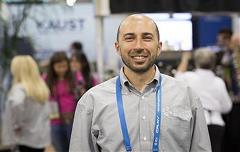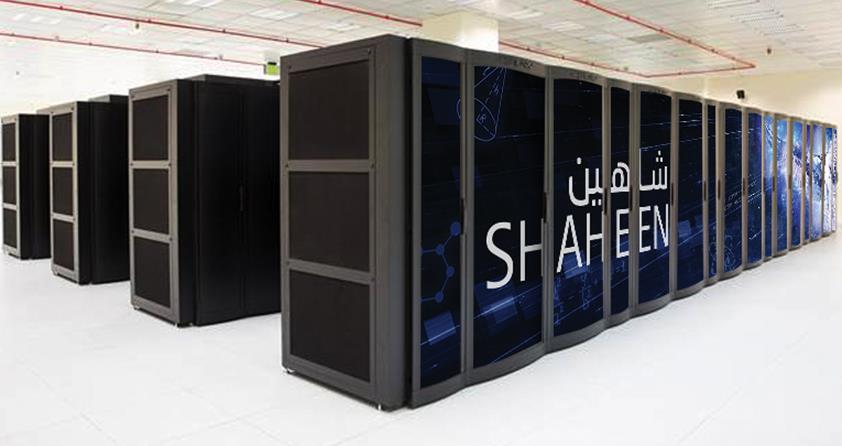By Nicholas Demille, KAUST News
On October 28, the KAUST Cray XC40 supercomputer Shaheen, the fastest supercomputer in the Middle East, made headlines when it completed the world's first trillion cell reservoir simulation. A Saudi Aramco research team led by fellow Ali Dogru conducted the reservoir simu lation using Shaheen and the company's proprietary software TeraPOWERS. The Aramco researchers were supported by a team of specialists from the KAUST Supercomputing Core Lab, with the work rendering imagery so detailed that it changed the face of natural resource exploration.

Ph.D. students (right to left) Ehab Abdelhamid, Ibrahim Abdelaziz and Fuad Jamour on the floor of the SC16 supercomputing conference in Salt Lake City, Utah. By Nicholas Demille
"The 'trillion cell' designation refers to how dense and high-resolution the imagery is," explained KAUST Computational Scientist Lead Saber Feki. "Think of it this way: we all carry megapixel cameras in our pockets. The Saudi Aramco team just simulated subsurface images with six orders of magnitude higher resolution on our machine. It's research that will yield much more reliable information for oil exploration and production"
Saudi Aramco owns a number of supercomputers, so why did the company turn to KAUST to run the simulation? The answer lies in the facilities and expertise the University offers.
Power, security and brains
To run a world's first simulation, the Saudi Aramco team needed the kind of raw computing power that a machine like Shaheen offers. Run on a smaller cluster, this type of simulation could take weeks or even months. With such a large and complex endeavor, computing power was an essential starting point.
Also, because of the highly secretive nature of the proprietary software and data that the Aramco scientists needed to transmit, an iron-clad level of information security was essential. The University's Supercomputing Core Lab is one of the few places in the region that has the capability to create a gateway into the supercomputer that is so airtight that even the operators of the machine could not see the data stream.
Most importantly, the Aramco team needed a partner institution with the brainpower to prepare the supercomputer in the manner necessary to execute such an undertaking. The KAUST team spent the better part of a week preparing to host the simulation.
“We could not have achieved this incredible milestone without the expertise and resources from KAUST, which provided superb support,” lead TeraPOWERS developer Larry Fung said in a Saudi Aramco press release.
Jysoo Lee, director of the KAUST Supercomputing Core Lab, noted, "People don't always appreciate the human capital. The big machine takes the headline, but in order to provide these services, we have to have the human capital. You can't just plug this in and start offering services."
A millennial pursuit
Drilling for oil is an ancient tradition. Records indicate that the first wells may have been drilled as early as 300 C.E. By the 9th century, Arab and Persian chemists were refining petroleum products for use in lighting and arms. For much of recorded history, the problem was not so much drilling into the earth—although that is often challenging—but where to drill. Saudi Aramco's trillion cell simulation largely solved that.

Computational Scientist Bilel Hadri on the floor of the SC16 supercomputing conference in Salt Lake City, Utah. By Nicholas Demille
“Using trillions of cells in a reservoir simulation environment was a long-awaited dream for the global petroleum industry and scientific community,” noted Dogru in a Saudi Aramco press release. “This achievement opens the door for us to simulate the Saudi Arabian peninsula in its entirety as one model using the reservoir simulation grid. This means that we will be able to examine the peninsula under the microscope for new oil and gas fields.”
Serving the campus and the Kingdom
A number of Saudi institutions use Shaheen, including King Fahd University of Petroleum and Minerals (KFUPM) and King Saud University (KSU), to develop their work and examine new fields of research. Companies like the Saudi Basic Industries Corporation (SABIC) also use KAUST supercomputing resources to enhance their business in chemistry and chemical catalysis research.
"KAUST has been contributing to the advancement of the Kingdom of Saudi Arabia by educating future leaders in science and technology and by finding technical solutions to problems the Kingdom faces," said Justin Mynar, director of the University's Core Labs. "The KAUST Core Labs have been maintaining world-class, state-of-the-art facilities for the KAUST community, and the University's collaborators and I feel that Shaheen is a national asset that should be further utilized to meet demands from organizations around the Kingdom."
The KAUST Core Labs has been busy promoting the University as an ideal research partner for the Kingdom's institutions. Earlier this year KAUST, signed an agreement with the Aviation Investigation Bureau, an independent governmental organization that needed to decrease dependence on international resources while utilizing expertise and facilities within the Kingdom.

Computational Scientist Saber Feki on the floor of the SC16 supercomputing conference in Salt Lake City, Utah. By Nicholas Demille
KAUST Computational Scientist Bilel Hadri presented the Supercomputing Core Lab scientists' research on the use of burst buffer technology to boost simulation speeds
The future of HPC
In March of 2017, KAUST will host HPC Saudi, a premier regional event where participants can meet, share ideas and develop collaborations. This will be the seventh edition of the HPC Saudi conference, and this year it will focus on coordinated efforts for the advancement of the HPC ecosystem in the Kingdom.
"The lag in the region is the development of people to run and utilize these systems. We want to increase the human capital in this regard. There are three speakers from the world and three from the country so that they can discuss and formulate a new initiative for HPC development," Lee said.

